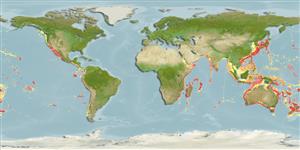>
Anguilliformes (Eels and morays) >
Nettastomatidae (Duckbill eels)
Etymology: Nettastoma: Greek, netta = duck + Greek, stoma = mouth (Ref. 45335); parviceps: From the Latin parvus meaning little and caput meaning head, referring to the slightly smaller size of the head of this species compared to that of N. melanura, the only other species of the genus known to Günther..
More on author: Günther.
Environment: milieu / climate zone / depth range / distribution range
Écologie
marin benthopélagique; profondeur 60 - 1190 m (Ref. 40819). Deep-water
Indo-Pacific: bitemperate distribution, recorded from Japan, Hawaii, eastern Australia, and southeastern Africa. Southeast Pacific: Chile (Ref. 9068). Rare or absent in equatorial waters.
Taille / Poids / Âge
Maturity: Lm ? range ? - ? cm
Max length : 82.0 cm TL mâle / non sexé; (Ref. 6591)
Description synthétique
Morphologie | Morphométrie
Vertèbres: 230. SO5 pore normally absent. Lateral line pores 49-58. Median vomerine teeth not enlarged. Posterior nostril above posterodorsal corner of eye. Other characteristics: Color gray; vertical fins black-edged; snout gray-black; iris and opercular regions silver.
Inhabits the continental slope (Ref. 7300, 75154) and shelf (Ref. 75154).
Life cycle and mating behavior
Maturité | Reproduction | Frai | Œufs | Fécondité | Larves
Castle, P.H.J., 1986. Nettastomatidae. p. 190-191. In M.M. Smith and P.C. Heemstra (eds.) Smiths' sea fishes. Springer-Verlag, Berlin. (Ref. 6591)
Statut dans la liste rouge de l'IUCN (Ref. 130435)
Menace pour l'homme
Harmless
Utilisations par l'homme
Pêcheries: sans intérêt
Plus d'informations
Noms communsSynonymesMétabolismePrédateursÉcotoxicologieReproductionMaturitéFraiRassemblement de ponteFéconditéŒufsDéveloppement de l'œuf
Taille/ÂgeCroissanceLongueur-poidsLongueur-longueurFréquences de longueursMorphométrieMorphologieLarvesDynamique des populations larvairesRecrutementAbondanceBRUVS
RéférencesAquacultureProfil d'aquacultureSouchesGénétiqueElectrophoresesHéritabilitéPathologiesTraitementNutrientsMass conversion
CollaborateursImagesStamps, Coins Misc.SonsCiguateraVitesseType de nageSurface branchialeOtolithesCerveauxVision
Outils
Articles particuliers
Télécharger en XML
Sources Internet
Estimates based on models
Preferred temperature (Ref.
123201): 7.8 - 17.5, mean 11.5 °C (based on 548 cells).
Phylogenetic diversity index (Ref.
82804): PD
50 = 0.5312 [Uniqueness, from 0.5 = low to 2.0 = high].
Bayesian length-weight: a=0.00089 (0.00036 - 0.00223), b=2.98 (2.77 - 3.19), in cm total length, based on LWR estimates for this (Sub)family-body shape (Ref.
93245).
Niveau trophique (Ref.
69278): 3.5 ±0.5 se; based on size and trophs of closest relatives
Résilience (Ref.
120179): Faible, temps minimum de doublement de population : 4,5 à 14 années (Assuming tmax>10).
Fishing Vulnerability (Ref.
59153): Moderate to high vulnerability (53 of 100).
